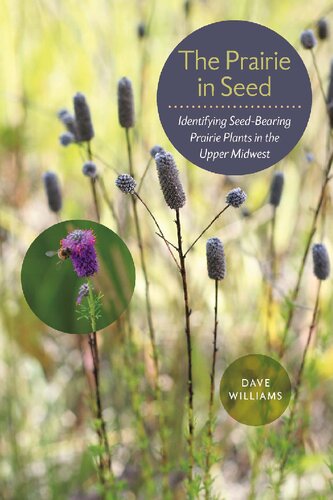Product desciption
The Praire In Seed Identifying Seedbearing Prairie Plants In The Upper Midwest Dave Williams by Dave Williams 9781609384098, 9781609384104, 1609384091, 1609384105, 2015028384 instant download after payment.
Preface and Acknowledgments
In recent years, the tallgrass prairie has been proven to offer solutions to many
environmental challenges associated with our water, soils, and wildlife ecosystem.
While cities like Des Moines, Iowa, for example, struggle to control nitrate levels
in their drinking water with expensive filtration systems, Iowa State University
researchers have found that planting prairie on 10 percent of a field can effectively
remove excess phosphorus and nitrogen from the remaining 90 percent (Zhou et
al. 2014). We also know that deep prairie roots and dense, aboveground growth
work together to filter and hold midwestern soils, effectively keeping them from
eroding into our streams and rivers and offering the potential to slow or even stop
the expansion of the dead zone in the Gulf of Mexico. More recently, specific native
prairie plants such as the common milkweed have been identified as key to recovery
for the monarch butterfly, perhaps even keeping it from becoming an endangered
species (Pleasants and Oberhauser 2012).
Americans’ century-old
love affair with European turf grass is slowly giving way
to discovery of the benefits and beauty of our original native prairie. Many states
enjoy broad public support for revegetating road rights-of-
way
with prairie wildflowers
and grasses in lieu of mowing, which reduces maintenance costs while providing
a colorful blooming landscape from early spring through fall. It is common
to see prairie plants used in landscaping at city parks throughout the Midwest, on
golf courses and along trails, around businesses and industrial parks, and more
recently in residential yards as homeowners tire of chemicals, turf maintenance,
and a bland green landscape.
As interest in prairie wildflowers and grasses has grown, so has demand for better
resources to identify the hundreds of species of wildflowers and grasses that
make up the native prairie from the time they emerge as seedlings until they set
seeds. In The Tallgrass Prairie Center Guide to Seed and Seedling Identification in
the Upper Midwest (2010), I documented an initial group of native prairie plant
seedlings through photographs, descriptions, and drawings to help prairie advocates
identify seedlings in the spring. There are a multitude of excellent books that
help identify prairie plants once they are in flower, based on flower color and shape.
Once they are out of bloom, however, it can be difficult to spot and identify prairie
plants. Without the flower color and shape to guide us, distinguishing between a
simple prairie sunflower and an ox-eye
sunflower can be almost impossible.
The Prairie in Seed is designed to assist the prairie advocate in identifying wildflowers
once they are out of bloom and, in particular, to support those who harvest
prairie seeds. This guide offers dormant plant identification, seed descriptions, and
guidance for effective seed harvesting and cleaning for seventy-three
of the most
common wildflowers found in the tallgrass prairie. I have used The Vascular Plants
of Iowa: An Annotated Checklist and Natural History by Lawrence J. Eilers and
Dean M. Roosa (1994), An Illustrated Guide to Iowa Prairie Plants by Paul Christiansen
and Mark Müller (1999), and the USDA Natural Resources Conservation
Service PLANTS Database for binomial nomenclature.
I would like to thank the University of Northern Iowa Tallgrass Prairie Center
(TPC) for giving me the time and equipment to pursue this project. I am sincerely
thankful to my colleague Gregory Houseal at the TPC for his botanical expertise
and manuscript editing. Thanks to Holly Carver and Karen Copp at the University
of Iowa Press for editing and design work on the manuscript. This guide was
funded by the Iowa Department of Transportation, Iowa Living Roadway Trust
Fund.
Remember to get permission if you are harvesting seeds on private or public
property, and do not harvest in an area designated as a preserve. Good harvesting
ethics is to take only half and leave half on the site. Good luck!


